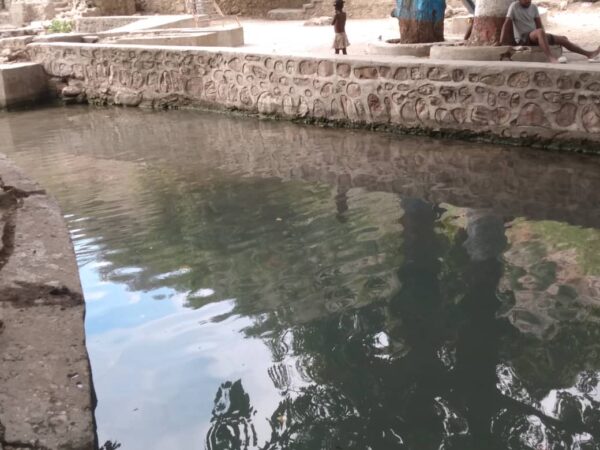“We risk losing the Imperial Spring if nothing is done,” warns Chavannes Victor, former caretaker of the Claire-Heureuse house located in the commune of Marchand Dessalines
In Marchand Dessalines, when Chavannes Victor is not working in his garden, we find him at the Imperial Spring, where he acts as an intermediary for pilgrims and visitors, who come to address their requests to the venerated spirit called Félicité, indisputable mistress of the place.
A view of the Félicité basin. | © Fidano Daméus
This spring, feeding the Félicité basin, is located inside Fort Tumbledbuilt by Jean-Jacques Dessalines in 1804 to protect the city against a possible return of the French.
Today, water from this spring is used to supply the taps in much of the city.
For the inhabitants of Dessalines and adherents of voodoo, the Félicité basin, said to have belonged to the Empress Marie-Claire Heureuse Félicité Bonheur, wife of Emperor James Iis endowed with great atoning virtues.
For several years, the cutting of trees and the clandestine exploitation of building stones on the slope overlooking the basin has put this heritage site in great danger, according to witnesses familiar with the situation, contacted by AyiboPost.

A view of the slope overlooking the Félicité basin. Deforested. | © Fidano Daméus
Headed by the Ministry of Culture and Communication, the Institutefor theConservationof NationalHeritage (ISPAN) is responsible for the management and preservation of the country’s historic sites.
Contacted by AyiboPost, the institution did not respond to a request for comment before the publication of the article.
Read also: Sugarcane cultivation explodes in Saint-Michel-de-l’Attalaye
Chavannes Victor describes himself as a “servant” of the deity inhabiting the spring.
The 55-year-old man was born and raised in Marchand Dessalines.
His life story is inextricably tied to the fort and the Imperial Spring.
In its heyday, the water that flowed there was clear and fresh. Birds mingled their melodies with the whispers of the wind in the leaves of the century-old trees.
But in recent years, a management problem has compromised the preservation of the site.
Victor speaks of it as a lost paradise.
“Today it’s not the same. We risk losing the Imperial Spring if nothing is done,” warns the former caretaker of Claire-Heureuse’s house located in the same city.
In recent years, the cutting of trees and the clandestine exploitation of building stones on the slope overlooking the basin has put this heritage site in great danger.
Located in the Artibonite department about 160 km north of Port-au-Prince, the commune of Marchand Dessalines was the first capital of Haiti.
As such, this town founded in 1802 which bears the name of its founder, Dessalines, can boast half a dozen forts dating back to the 19th century and other sites attesting to its undeniable historical past.
“The Imperial Spring is a site that is both historical and mystical, occupying a special place in the imagination of the inhabitants of Marchand-Dessalines,” says Kessel Damier, president of the Dessalines Tourism Office (OTD).
“According to the story, Damier continues, more than two centuries ago, the imperial couple would have made it a habit of swimming in the Félicité basin. Jean-Jacques Dessalines took his bath there, before attending his meetings.
When they were younger, Damier and his friends visited this place several times a day, diving in for invigorating baths and relaxation.
Something he regrets he cannot do today.
“The water in the basin is now muddy and full of rubbish. And the degradation of the surrounding area is concerning,” worries Damier.
According to the official, this situation dates back to at least 2010.
According to the story, […] more than two centuries ago, the imperial couple would have made it a habit of swimming in the Félicité basin. Jean-Jacques Dessalines took his bath there, before attending his meetings.
Despite multiple interventions to raise awareness of the danger, “we don’t feel we’ve been heard,” says Damier, fearing the worst.
Read also: Historic residences, abandoned under the watch of the Haitian government
Vixama Phito, administrative director of the Dessalines City Hall, recognizes the environmental challenges that threaten the spring.
But the municipal authority lacks the means to pay the two field agents under contract, responsible for monitoring the area, reveals the administrator.
According to him, even if the impacts remain limited, several interventions have been carried out on the site since the 1990s.
In 1997, an initiative from the town hall made it possible to install stone borders around the pool.
Other interventions were made by ISPAN in the late 1990s and early 2000s. Support walls were also erected along the slope overlooking the spring to prevent erosion likely to draw alluvial deposits into the Félicité basin during rainfall.
These protective structures are under attacked by some individuals.
“They cut down trees to make charcoal and destroyed the retaining walls to extract stones for construction,” laments Vixama Phito.

Individuals have destroyed retaining walls and cut down trees. | © Fidano Daméus
This situation is at the root of the degradation of the spring’s immediate environment.
Faced with these challenges, city hall authorities are unable to count on the support of the police who face a manpower problem and lack the means to travel to “counter these malicious individuals who generally operate at night.”
“If it wasn’t for our vigilance, people would have already built in the vicinity of the site,” enthuses Vixama Phito.
Richemont Joseph, 60 years old, is one of the contract workers mentioned above.
The man has worked for ISPAN for around 20 years.
But for six years, Joseph has not received any salary from the institute. “There’s almost no management of the space anymore,” Joseph laments.
The traces of insecurity, manifested by the actions of armed gangs, are also visible in the commune of Dessalines.
Every August 11, the inhabitants of Marchand Dessalines celebrate Sainte-Claire, their patron saint.
During these festivities, this site, represented by the Imperial Spring and Fort Culbuté (also called Fort la Source) is a tourist and mystical attraction very popular with pilgrims from everywhere.

Partial view of Fort Culbuté. Built in 1802 to protect the water sources that supply the town of Dessalines. | © Fidano Daméus
For at least five years, this flamboyant attraction has suffered a great chill.
“People hardly come anymore,” complains Chavannes Victor, recalling the deadly abuses of the Savien and Kokorat San Ras gangs who mercilessly sow mourning and terror on the main roads leading to the town of Dessalines.
Read also: Saint-Michel clairin producers struggle to make deliveries, as gangs guard roads
For his part, Richemont Joseph fears the worst.
“It would be a disaster if the town managed to lose such an important site like the Imperial Spring,” he says.
Fidano Daméus from Marchand Dessalines participated in this report.
Keep in touch with AyiboPost via:
► Our channelTelegram : Click here
► Our ChannelWhatsApp : Click here
► Our CommunityWhatsApp : Click here


